


|
|
 Georgia has great woodlands and great countryside that is fun to explore and to visit. As a reminder it is still natural and filled with pitfalls for the unwary. Here are some suggestions on how to avoid making an otherwise pleasant trip into a nightmare.
Things to avoid
Snakes We cover snakes first, not because they are the most dangerous but because most people seem to have an inordinate fear of these usually reticent animals. Most snakes encountered are not poisonous and serve a useful purpose in the forest. They do a great deal to control the populations of insects, rodents, and birds. Other than the coral snake, Georgia's poisonous snakes are pit vipers. They can be readily distinguished by their arrow head shaped heads.
It is a good rule to never handle snakes. Even non-poisonous snakes can deliver a painful bite. Snakes appearing dead can be quite alive. Snakes may feign death to discourage their attackers only to "come alive" at the most inopportune time. One of our customers was bitten by a "dead" eastern diamondback rattlesnake that he held to display as a trophy.
Watch your step. The quickest way to a bite is to step on a venomous snake. Simply by looking where you step you can avoid the biggest pitfall. Stepping near a snake is not likely to produce a strike. Be careful stepping over logs since you can't see behind the log and it is a favorite place for snakes it is a recipe for a strike. Step on the log rather than over them.
Be careful when you pick up things. A log pile is the perfect place for a snake to ambush its prey. Bites on the hands or arms can be the result of carelessly picking up items within the snake's habitat.
Certain areas are more prone to snakes. Be more watchful around areas that have natural sources of water. Snakes like to ambush their prey on the way to the watering hole.
Snakes are cold blooded and therefore take their temperature from their surroundings. Snakes can be active above about 60 degrees Fahrenheit. Snakes can be found out and about any time of the year as long as the temperature rises above the range of 60 degrees. I have seen a number of snakes in December and January.
Snakes are at their most dangerous in the fall since it is the time when they molt or lose their skin. Molting causes the snakes to be vision impaired and this vulnerability leads the snake to strike and ask questions later.
Wear boots, and if you make many trips into the woods during the summer, I would suggest snake boots. Unlike their earlier predecessors, modern snake boots are light and covered with a layer of Kevlar which is probably more known for its use in bullet proof vests. These boots are also useful in preventing scratches from briars and brambles.
Remember that snakes are just a forest species and rarely cause harm to man. Don't kill snakes, even poisonous ones just because you have a fear of them. Unless they are trying to establish themselves in an area frequently by children or pets, the best recourse may be to live and let live.
Rattlesnake - Georgia has its share of rattlesnakes. They are pit vipers and are readily defined by the prominent rattle at the end of their tail. Georgia has many species but the timber rattler (also known as the canebrake), and the eastern diamond back are common. The eastern diamondback can be large approaching 6 feet and with a very thick body. A common misperception is that they always rattle upon approach. Rattlers may never warn of an impending strike and I have stepped within three inches of large snakes without even a hint of a rattle.
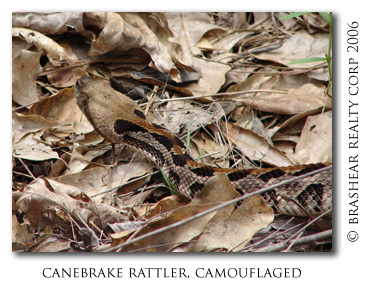  Canebrake or Timber Rattler - Richmond County, Georgia
Water Moccasin - These snakes are also known as cotton mouths. This term stems from the almost white appearance of the flesh on inside of their mouth. They too can be a large snake upwards to 5 feet in length with large bodies. They can be a very aggressive snake. They are always found near lakes or streams. Fish and frogs are a large part of their diet. They are colored anywhere from brown to an almost black.
Copperhead - Copperheads are known for their copper color. They tend to be the smaller of the pit vipers and found even as adult in the two to three foot range. Snake bites from this species are rarely fatal but can be quite painful. The immature copperheads sometimes have a yellow tail.
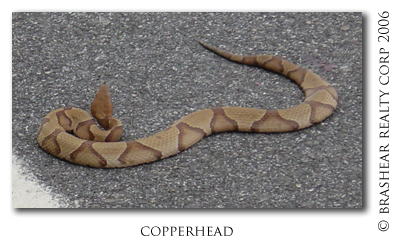 Copperhead - Burke County, Georgia
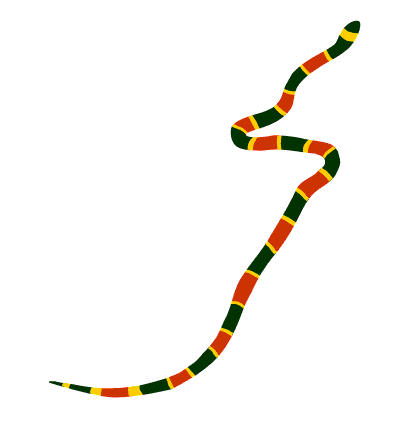
Coral Snake - The coral snake is the only venomous snake that is not a pit viper that can be found in Georgia. This snake is rarely seen in our section of Georgia (East Central), but it is more commonly in the coastal plain. It is sometimes confused with the non venomous scarlet king snake. This snake is known for its neurotoxin venom. It is highly reclusive is most likely found in the ground or in decaying stumps. Rather than a quick strike is likely to chew protruding fingers. It can be distinguished from its mimic snakes by the old axiom "red on yellow kill a fellow." A black head is also a distinguishing characteristic of this species.
Insects
Yellow Jackets - These stinging insects are too often underestimated. Their sting is painful and can last as long as a week. Their true danger lies in their aggressive behavior coupled with the propensity to attack in large numbers. Yellow jackets usually burrow in the ground and in old stump holes. If you spot a ground area where numbers of the insects are swarming, avoid the area. Stepping into their holes can prompt a vicious response and you may have to run three hundred yards to escape their attacks. Their stings are immediately painful and have been likened to being struck by bullets. If you are stung you should immediately flee the area since other attacks are likely.
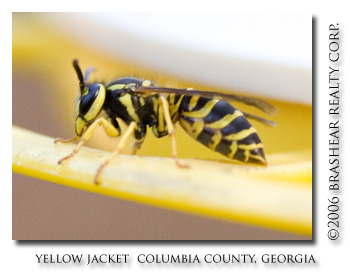 Horse flies - Horse flies have an annoying burning bite. They are quite often found in areas near water and can be quite an irritant to bathers.
Deer flies - These insects are mostly an annoyance. They have a mild sting but can be unmanageable in large numbers. They are usually found south of the fall line and can be found in large numbers around swamps and creeks. A good aerosol spray with DEET around the head and arms can help and a hat can save your sanity.
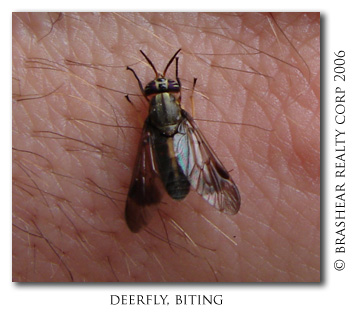 Wasps - Wasps have a sharp sting but fortunately it usually subsides with a few hours.
These insects are quite often found in barns or old buildings, so beware of unpleasant surprises in exploring ruins.
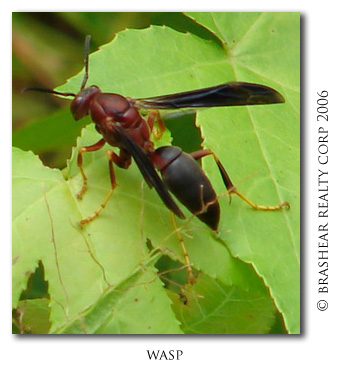 Hornets - Hornets also have a sharp sting. They can be found in large colonies usually in papery football shaped nests. Their reputation is probably worse than their stings. While painful they are similar to the wasp.
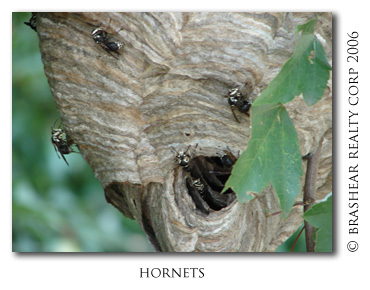 Mosquitoes - The destroyer of the backyard barbeque also lives quite well in the forests. Generally they are considered no more than a nuisance, but more recently they have been implicated as a carrier of such diseases as the West Nile Virus. Prevention is the key to dealing with this insect. They reproduce only in stagnant waters so elimination of breeding grounds is a key to control. On properties where such things as tire dumps are kept, the mosquito can rapidly reproduce. There are particularly heavy concentrations in and around swamp lands where stagnant pools are common. Exposure can be limited with long sleeves, hats, and DEET aerosols. Where you are stationary Citronella candles can be of help.
Fire Ants - This newcomer to our area has infested almost the whole state. Their sting belies their size. A sting can provide days of pain and swelling. Their real danger is in the possibility of standing on a mound without being aware. Your shoes and clothes can be filled with hundreds of the little stingers before you become aware of the first sting. If this should occur, my suggestion is to immediately remove your pants and try to rid the clothing of their nasty little pests before putting them back on. If your surroundings and modesty won't permit this, then turning the legs inside out might help.
Their telltale mounds are everywhere. Eradication is not a possibility at this time, so control is more the issue. There are numerous fire ant killers available on the market but these can only control the insects in a limited area for a limited amount of time.
Arachnids Our forests are full of spiders and most do no harm. Two spiders in particular are worthy of note:
Brown Recluse - This medium sized brown spider can be recognized by the violin shaped markings just behind the head of the spider. It has a venomous bite. Reaction to the bite varies from a slight swelling to a large swelling with eruptions and bleeding. This spider can quite often be found in homes or other covered spaces. Quite often the victim has no remembrance or sensation of being bitten. The sudden discovery of the swelling precedes any sensation of pain. Brown Recluse spiders are rare in our area.
Black Widow - This spider is the subject of much lore. The female spider's habit of eating its mate leads to its colorful name. This otherwise black spider has the marking of a red hour glass on its abdomen. The bite is painful and lasts for several days. This spider is commonly found in our area. You can prevent bites by wearing gloves if you are working outdoors with your hands. Check your shoes before you put them on, particularly if you left them outdoors during the night.
Ticks -These annoying pests can be found throughout Georgia but a worse in certain areas. The number of insects per acre is found to be higher where the deer population is the highest. These blood sucking parasites can spread any number of viruses, bacteria, and protozoa. The are know carriers of Lyme disease and Rocky Mountain Spotted fever. The key to dealing with these insects is to prevent bites. If you are going into the woods, spraying with insect repellents can minimize your risk. Use repellents containing 100% DEET along your pant legs and boots, while using 25% DEET repellents for your upper clothes and skin. I would not recommend spraying 100% DEET on your skin. A thorough inspection of your clothing, hair and skin after a trip to the woods can further minimize your bites. Keep an eye to the seats in your vehicle since the insects can leave your clothes for your vehicle seats and you can get bitten days later.
If you are bitten, remove the tick as soon as possible. Try to avoid removing the tick in such a manner as to cause the tick to disgorge blood back into your system. This can cause pathogens to enter your blood stream. Try to grasp the head of the tick with tweezers and pull straight out. Ticks attached for less than four hours are less likely to cause diseases so early removal should be a priority.
Despite all of the negative press, I have been bitten hundreds of times without incident.
Red Bugs, or "Chiggers" or "NoSeeUms" are all the same species. They are generally not visible to the naked eye and usually exposure to these creatures is known only after the fact. The first evidence is a reddish whelp that has a tremendous itch. It will usually persist for a couple of weeks. The bites of these mites usually tend to be in areas that are tight such as skin or clothing folds.
Prevention precautions include those for ticks. DEET at 100% for shoes and pant legs helps tremendously. Avoid sitting on stumps or grass since they can have heavy infestations. While many suggestions have been handed to me for relief the only thing I have found helpful are topical anti-itch medications and two weeks.
 Scorpion – The scorpion can be found in much of Georgia, however its bite is similar to a wasp or hornet. It is not the dreaded killer as it has been portrayed in many a cheap thriller. This creature can be found under rocks or in stumps or decaying wood. The stinger is located in the tail.
Plants
TheToxicodendron family includes Poison Ivy, Poison Oak, and Poison Sumac. Poison Sumac is generally not found in our area so we will center our discussion on Poison Ivy and Poison Oak.
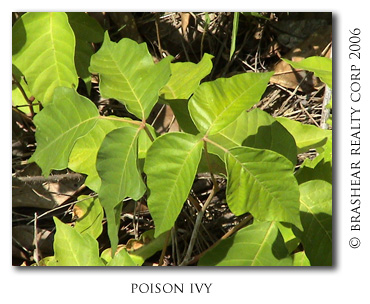 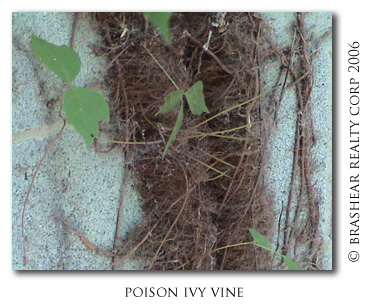 Poison Ivy - This is probably the one danger you are most likely to encounter on your trip to our woods. It is the exception when I don't see this ubiquitous vine. Poison Ivy can be found growing as a small plant, a large vine, or even a shrub. Its vine can be identified by the hairy appearance. It may have berries. It can have varied colors from red to green but is most often green.
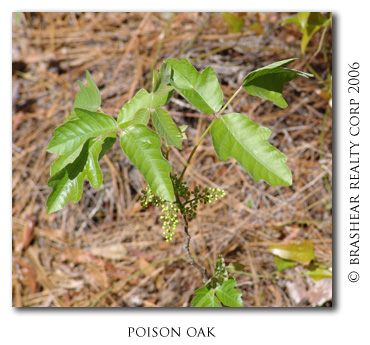 Poison Oak - This is a common plant found in our woodlands. It is usually found growing on the ground and is usually found in numbers rather than an isolated plant. It is sometimes confused with young oak trees since their leaves are similar. It too can have white or green berries and can have varying colors from red to green. While it can grow into a vine, in our area it is almost always a shrub.
In our woodlands both have three leaves per stem and leads to the old axiom "Leaves of three - let it be!" This is good advice.
The nasty rash that can ensue is mostly an immune system reaction to urushiol, a toxin found in the sap of Poison Oak, Poison Ivy and Poison Sumac. This sticky substance is the source of the terrible rashes that may result. You cannot get a reaction without exposure to this resin. Some simple precautions can help prevent a nasty reaction.
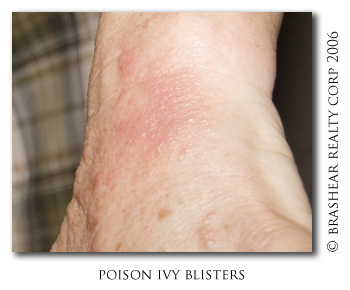 Learn to recognize these plants. Don't touch the plant. Do not touch your shoes if you have been in the forest. Too many times people walking in the forest suffer no exposure until they get home and remove their shoes with their hands, spreading the urushiol from their shoes to their hands and from there to wherever they place their hands. If you have been in an area that has exposed you to poison ivy or poison oak, bathe with soap and water, and wash your clothes before wearing them again.
You should never burn poison ivy or oak. The urushiol is released in the form of smoke and can cause a reaction in the lungs. This can be severe and may lead to hospitalization.
Don't be fooled by myths such as:
"Dead plants can't hurt you." Urushiol can persist for up to 5 years. Do not assume that dead plants cannot cause a reaction. "I'm immune." While it is true that some people don't have a reaction to even severe exposure, research indicates about 90% of people will react at some level. The more you are exposed the more likely you will have a reaction. Once you have a reaction the likelihood of a future reaction is increased. If you think you are immune, keep it that way by minimizing your exposure. "You can get poison ivy from the rash." Only urushiol causes the reaction. Once you have bathed thoroughly with soap and water the toxin has been removed. Sometimes different parts of the body have been exposed to different levels and the rash appears at different times. People who have had no prior exposure may not develop a rash for up to 10 days. Other plants - The real risk from other plants is not from touch but from eating poisonous berries or fruits. While I certainly enjoy eating blackberries, plums, mulberries and scuppernongs in the woods, I would suggest that if you are not sure of what it is, don't put it into your mouth. The wrong identification can be deadly.
Mammals As a general rule you should not expect wild animals to become a threat, but there are exceptions. Feral Hogs - Feral means that these were domesticated pigs that adapted to the wild. That is where the similarity to the barnyard variety ends. These fierce animals usually travel in groups and are generally regarded as destructive. Their presence is usually noted by vast areas that have been rooted. The area may look as if it had been plowed. When they feel cornered these beasts may attack and their razor sharp tusks can be formidable weapons. These animals may be hunted without regard to season in Georgia.
Bears - I have never seen a bear in the wild in our part of Georgia, although there is a population of bears in North Georgia. Suffice it to say these animals are large and unpredictable. Avoidance is the best course of action.
Skunks - You will not die from exposure to skunk spray, but you may not be popular at home. This persistent odor can stay with you for a long time.
Never approach animals in the wild. Observation is fine and a welcome part of spending time in the forest, but when an animal allows you to approach that is usually a sign that something is wrong. Rabies is still a problem in the forest and animals that behave strangely might have this disease. This is especially the case with raccoons. Avoid these animals. Even dogs found alone in the woods can be a threat. Finding the young of any animal might be interesting and a "Oh, how cute!" response, only to be met with a parent who is willing to attack to protect its young.
|